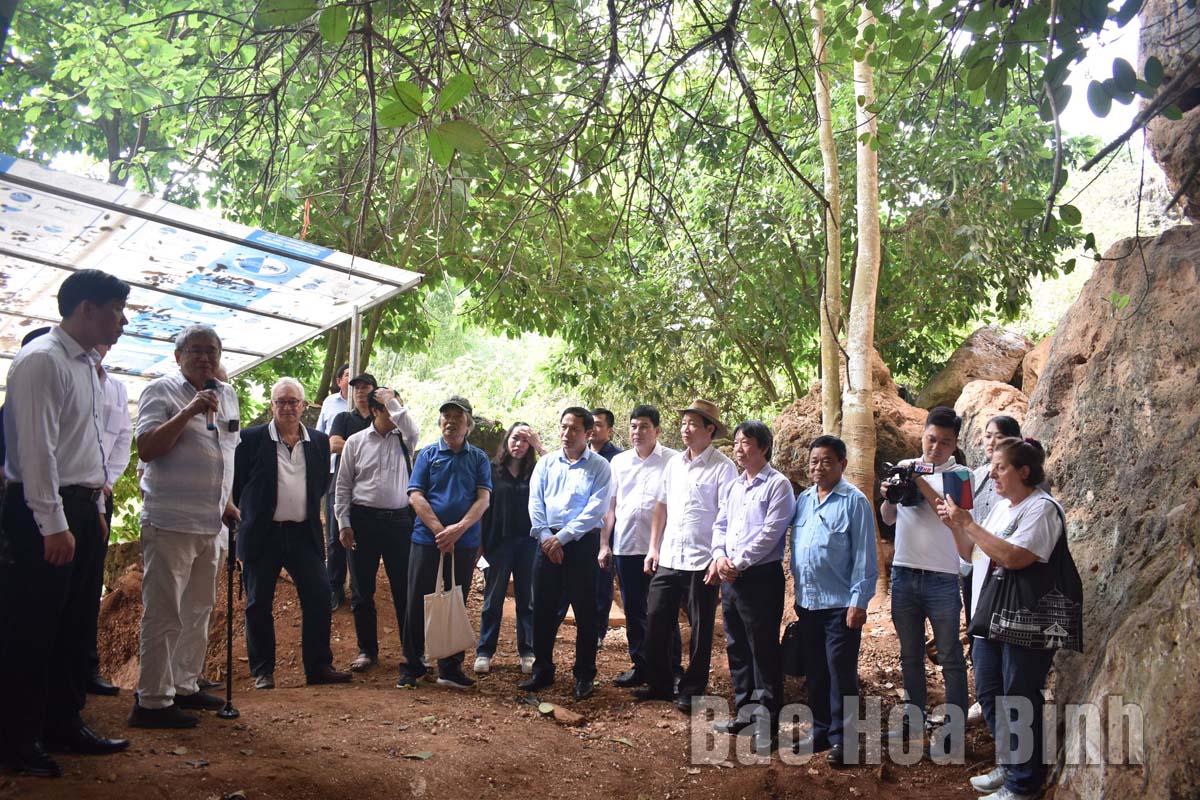
(HBO) – The organising board of a workshop marking 90 years since the world’s recognition of the Hoa Binh Civilisation held a tour of some typical archaeological sites of this civilisation on November 22. Participants included officials of the Ministry of Culture, Sports and Tourism, the ministry’s Cultural Heritage Department, the Institute of Archaeology, the Vietnam Archaeological Association, and domestic and foreign scientists. Vice Chairman of the Hoa Binh provincial People’s Committee Nguyen Van Toan, officials of some departments and sectors, and representatives of the Lac Son district People’s Committee also joined the delegation.

The delegation visits the Vanh Village stone shelter,
a relic site in Yen Phu commune of Lac Son district.
The delegation visited the Trai Hamlet cave in
Tan Lap commune and the Vanh Village stone shelter in Yen Phu commune, which
are typical archaeological sites of the Hoa Binh Civilisation. The Trai Hamlet
cave, discovered in 1975, has been excavated and studied for many years.
Research findings show that it dates back to the Hoa Binh Civilisation in the
Stone Age. In 2001, it was recognised as a national archaeological site.
Scientists found entrances to the cave in 2004 and 2008. Aside from stone tools
and food vestiges typical for the Hoa Binh Civilisation, many beautifully
decorated ceramic pieces and sharpened axes dating back 3,500 - 3,200 years
have also been unearthed at this cave.
Meanwhile, the Vanh Village stone shelter was
found by French archaeologist M. Colani in 1929 during an archaeological survey
of the southern limestone mountain area of Hoa Binh province. As many as 951
objects were collected there. In addition to hewn tools, a large number of
sharpened tools and stone bracelets were also discovered. According to the
study results announced in 1930, this relic site dates back about 17,000 -
8,000 years and belongs to the Hoa Binh Civilisation. Therefore, it was
classified as a site of the middle period of the civilisation.
During the tour, Dr. Nguyen Viet, Director of
the Centre for Prehistoric Southeast Asian Studies, updated participants on the
2022 excavation, which has given a further insight into the Hoa Binh
Civilisation. The latest research efforts revealed that this civilisation was
much older and more diverse than what have been known so far. Given this, more
interesting findings are expected in the future./.
The People’s Committee of Lac Son district held a ceremony on April 28 to receive the provincial relic certificate for the ancient rock carving site at Suoi Co stream, located in My Thanh commune.
A special music show titled "The country is in the fullness of joy” has been held at Hoa Binh Square in Hoa Binh city in celebration of the 50th anniversary of the liberation of the South and national reunification (April 30, 1975–2025).
The People's Committee of Lo Son commune, Tan Lac district, has organised the local annual traditional stream fishing festival on April 19 - 20.
As a land deeply intertwined with human history and Vietnam’s millennia-long journey of nation-building and defence, Hoa Binh is often revered for its epic tales and legends.
Residents of Hoa Binh boast a rich cultural identity, reflected in their unique language, traditional attire, customs, and folk melodies – described as "sweet as honey, clear as a mountain stream.”
Lac Son district’s Vu ban town held the 2025 Truong Kha temple festival on April 12–13 (the 15th–16th days of the third lunar month). Since its revival in 2019, the festival has been organised every three years, preserving valuable intangible heritage while meeting the community’s cultural and spiritual needs.



